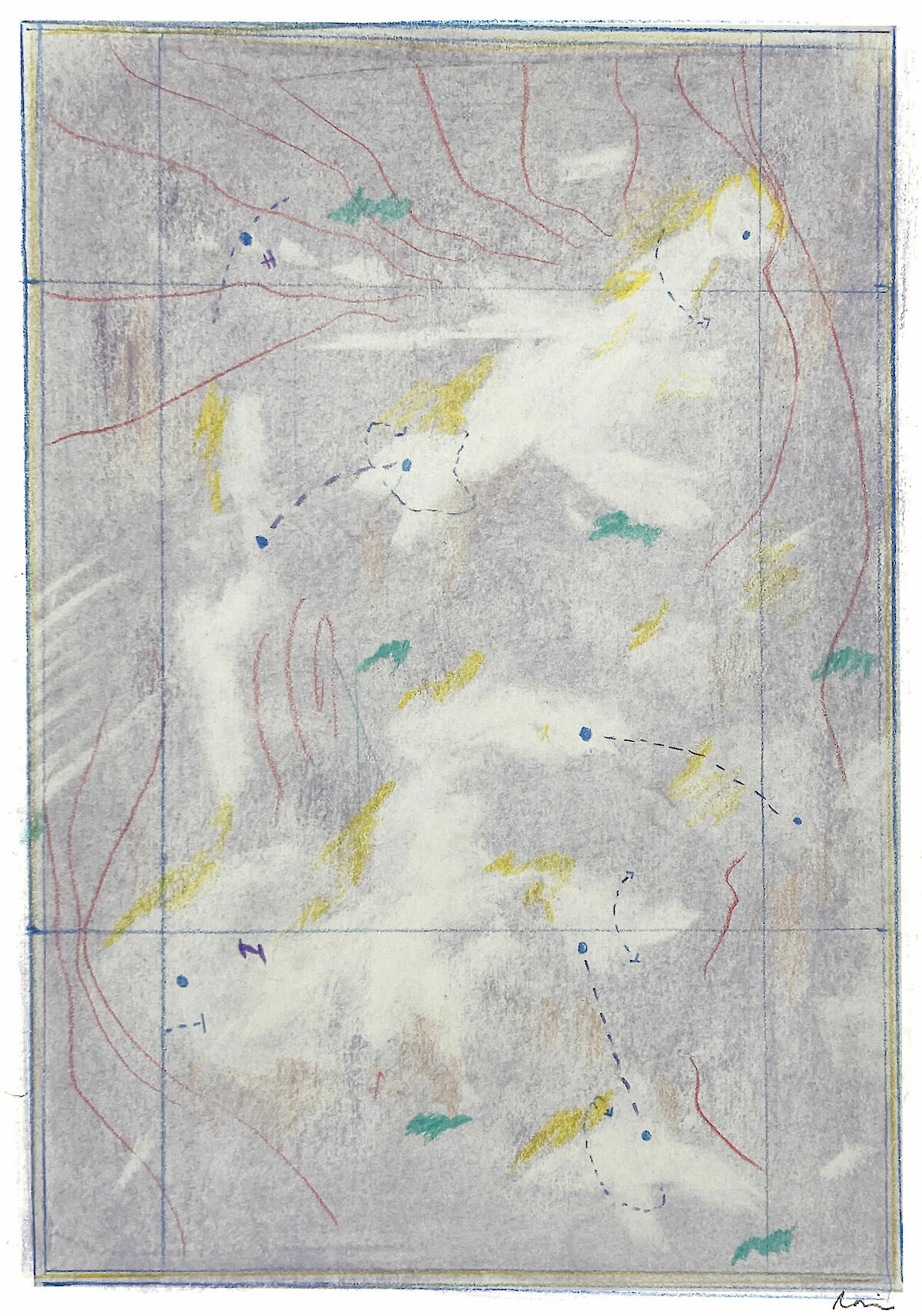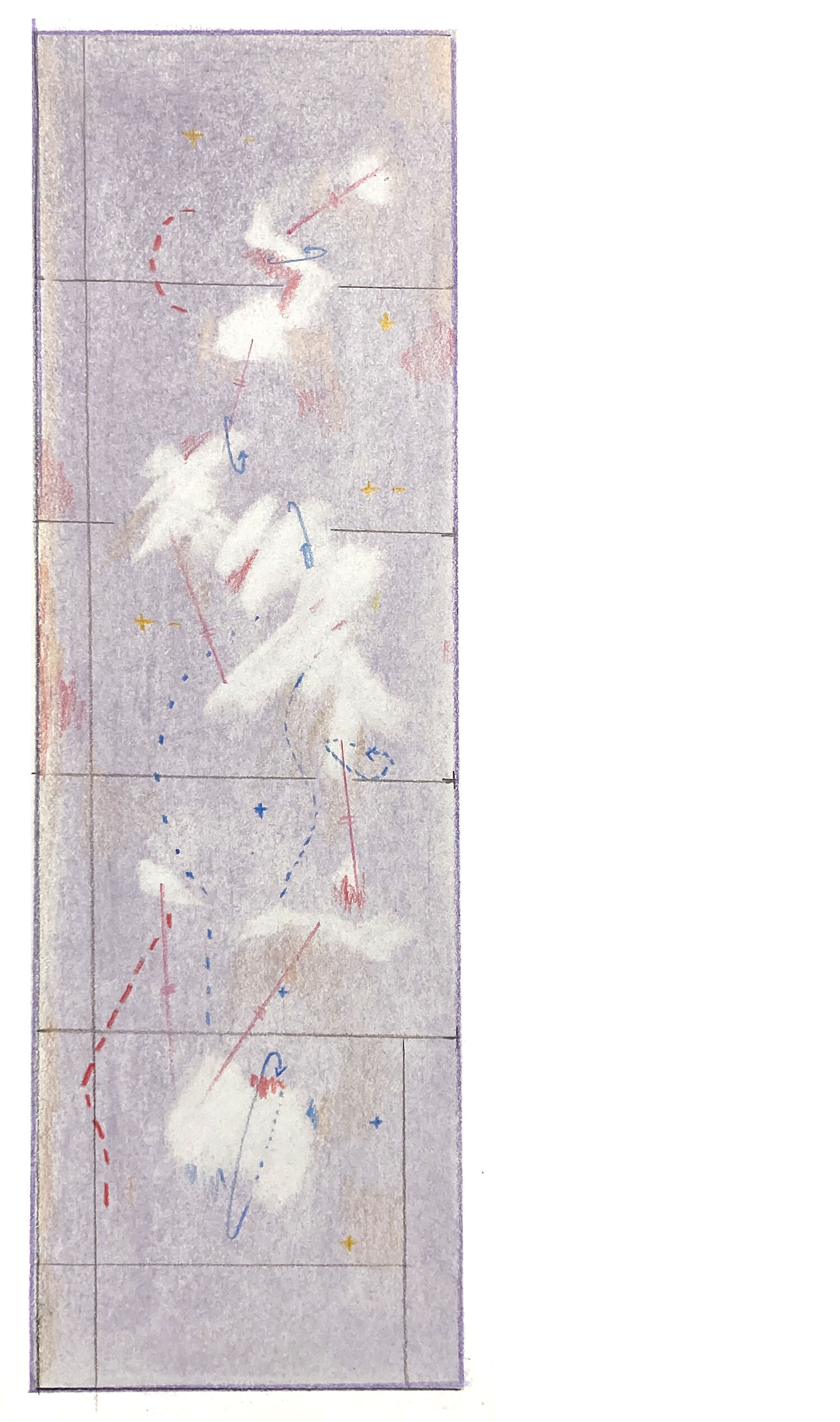 Rain Wu: Study – Events are recorded by the colour of the sky, 2021.
Rain Wu: Study – Events are recorded by the colour of the sky, 2021. Rain Wu: Study – Thoughts grow dimmer as they bounce a thousand times, 2021.
Rain Wu: Study – Thoughts grow dimmer as they bounce a thousand times, 2021.
 Rain Wu: Study, 2021.
Rain Wu: Study, 2021.
Seen in its pure materiality, as a giant rock speeding through outer space, our planet can be examined through the lenses of astronomy, geology, physics and chemistry. If we focus on the thin layer of life on its surface, however, we need to resort to a particular branch of biology, known as ‘ecology’ – literally, the ‘discourse around the home’. The prefix ‘eco’, from the Greek oikos, home, features in several other terms defining the set of all life-forms that inhabit a certain space – whether this is the fully material space of an eco-system, or the partly immaterial realm of the eco-nomy.
The use of ‘eco’, home, as a metaphor for all types of inhabited space, is a clear case of poetic anthropomorphism. We assign a familiar form to something which would otherwise be too obscure or too fuzzy to be treated conceptually. Anthropomorphism is, at least in part, a necessity dictated by the limits of human cognition. As observed by philologist Walter Otto, humans are capable of witnessing events only to the extent to which these resemble something human – hence, Otto suggests, the anthropomorphic shape taken by the Greek gods. As per Empedocles’ motto: “only like knows like”.
Aside from the necessity of anthropomorphism, however, the ‘eco’ metaphor is also justified by the peculiarity that is proper to the notion of ‘home’, especially as it was understood before the age of Modernity. According to a pre-Modern mentality, the home, like any other artificial object, is at the same time a product of human creativity and a mirror of the whole cosmos. In their work, pre-Modern craftsmen followed the metaphysical beliefs of their time, which saw reality as a complex realm composed of multiple dimensions, each of which carried within itself the reflection of all the others. The movements of the stars were seen as a macroscopic replica of our human vicissitudes, while the microscopic details of our lives reflected the structures and movements of all the other metaphysical dimensions.
Thus, for the pre-Modern, catering for human necessities did not only mean to satisfy our immediate needs. Every production, from the cast of a knife’s blade to the foundation of a town, aimed at combining immediate functionality with the establishment of a metaphorical link between different layers of reality. Even the ornaments inscribed on many pre-Modern tools were not intended as mere decorations, but they served as a visual aid to remind their user of the cosmic link between their individual activity and the eternal movements of the cosmos.
This is especially evident in the case of the pre-Modern architecture of the home. In its essential design, the home, with its walls dividing the ‘inside’ from the ‘outside’, replicated that structure which is dedicated par excellence to connecting different layers of reality: the temple. Vice versa, the temple carried in its architecture, and at times also in its name, a profound connection with the home – from the ‘oikos’ temples of classical Greece, to the Christian church as the ‘house of the Lord’.
From the Greek temnein, ‘to cut’, the temple was the essence of any space which was separated from its immediate environment – a sacred space-time, ‘cut out’ of the secular realm. Neither fully ‘here’ on Earth, nor fully ‘there’ in the heavens, the temple acted as an infrastructure through which it was possible to establish a communication between the different dimensions of reality. It was a place traversed by the axis mundi, the inter-dimensional beam connecting the underworld, the surface world, and the celestial realm. It was the ‘centre of the world’, out of which the whole of reality emerged as a kaleidoscopic spectacle of infinite refractions.
Similarly to the temple, also the pre-Modern home was designed to allow the passage of the axis mundi – from the hearth, as a gate to the underworld, through the opening at the top of the roof, gaping towards the sky. Like the temple, every home was also a ‘centre of the world’ – out of which every journey proceeded, and imaginations blossomed to become reality.
As with the temple, the contradiction of having as many ‘centres of the world’ as there are homes, was only apparent. Each person creates the world – in their own image, Empedocles would add – from the centre-point of their individual imagination, out of which they extract the metaphysical vision which they adopt as their own existential landscape. Each microscopic act of perception and imagination replicates the Divine creation of the entire macrocosm. Each home, whether of an individual or of a God, is the cosmogram of a multi-layered Totality.
Still today, it is possible to understand the contemporary discipline of ‘ecology’ as concerning something more than the mere discovery and cataloguing of the living systems on our planet. Considered through a pre-Modern perspective, as the science of the home, our current ecological consciousness can expand its perspective far beyond the ‘horizontal’ plane of the world. Following the axis mundi of our planetary home, it can proceed also ‘vertically’, towards a vision of all existents as multi-layered (and at times self-contradictory) beings, who reveal different parts of themselves in their different metaphysical dimension.
In the same way, the contemporary architecture of the home can still look beyond its immediate function as comfortable shelter and market commodity. By grounding the project of the home on the expanded metaphysics of their pre-Modern colleagues, contemporary architects can return our domestic spaces to the role of ‘inhabitable cosmograms’ – concrete images of the universe, which act as the silent educators of their users to a wide vision of reality as a multi-dimensional realm. A realm where ornament and function lie intertwined, and where enhancing the user’s understanding of the world is a crucial requirement for all forms of production.